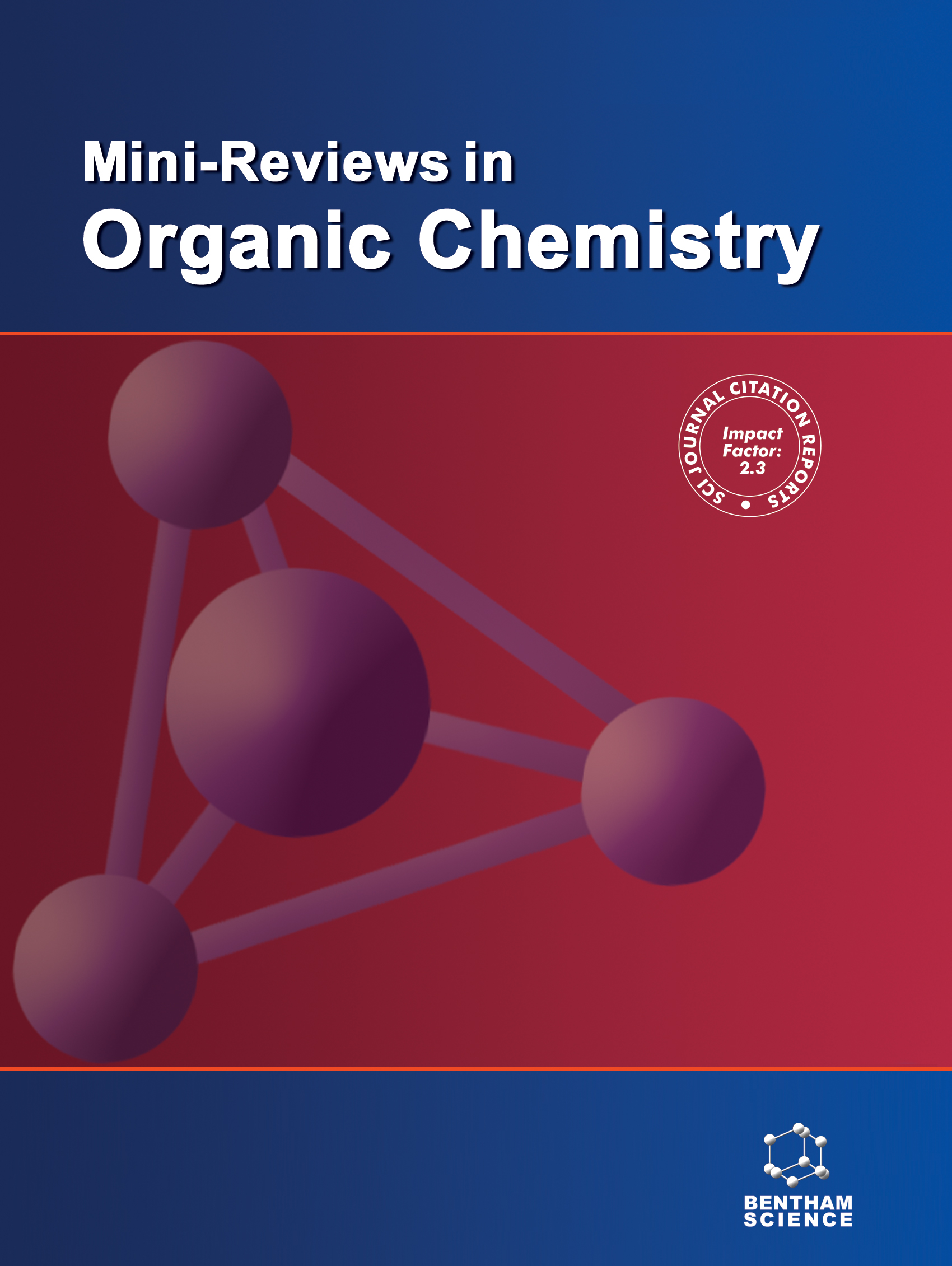- Home
- A-Z Publications
- Mini-Reviews in Organic Chemistry
- Previous Issues
- Volume 19, Issue 5, 2022
Mini-Reviews in Organic Chemistry - Volume 19, Issue 5, 2022
Volume 19, Issue 5, 2022
-
-
One-pot Synthesis of Pyrano[2,3-c]pyrazole Derivatives via Multicomponent Reactions (MCRs) and their Applications in Medicinal Chemistry
More LessAuthors: Swapan K. Biswas and Debasis DasBackground: Many pyrano[2,3-c]pyrazole derivatives display diverse biological activities and some of them are known as anticancer, analgesic, anticonvulsant, antimicrobial, antiinflammatory, and anti-malarial agents. In recent years, easy convergent, multicomponent reactions (MCRs) have been adopted to make highly functionalizedpyrano[2,3-c]pyrazole derivatives of biological interest. The synthesis of 1,4-dihydropyrano[2 Read More
-
-
-
Synthesis of Triazine Based Dendrimers: A Mini-Review
More LessAuthors: Anupama Singh and Sukhbeer KumariSynthesizing s-triazine dendrimers are interesting as they can be synthesized easily, contain diversity in composition, and have a basic potential for molecular recognition. Triazine trichloride is the molecule of choice for synthesizing a novel class of dendrimers as it possesses certain remarkable characteristics like the potential to expand the chemical functionality by nucleophilic aromatic substitution reactions at various temperat Read More
-
-
-
Utility of 1-(4-Substituted Aminophenyl)Ethanones in Heterocyclic Synthesis Part (II)
More LessThe improvement of new synthetic routes towards thiophene, oxazole, triazole, pyrimidine, pyridine, quinolone, coumarin, imidazopyrimidine, pyridoimidazole and triazolo[1,5-a] pyridine for their biological and medicinal exploration is an appealing vicinity for researchers. This review focuses on the utility of 1-(4-substituted-aminophenyl) ethanones and their derivatives as critical intermediates for the synthesis of thes Read More
-
-
-
The Synthesis and Chemistry of Quinolinediones and their Carbocyclic Analogs
More LessQuinoline-5,8-dione and naphthoquinone nuclei are very important substructures in industrial chemicals and pharmaceuticals. These compounds exhibit a wide variety of activities, including antifungal, antibacterial, antimalarial, antineoplastic, anticoagulant, anticancer, antiviral, radical scavenging, antiplatelet, trypanocidal, cytotoxic, and antineoplastic activities. Currently, several research articles on the importance of Read More
-
-
-
Degradation Mode of PBAT Mulching Film and Control Methods During its Degradation Induction Period
More LessAuthors: Runmeng Qiao, Xin Wang, Guangjiong Qin, Jialei Liu, Aocheng Cao, Canbin Ouyang and Wenqing HePlastic films play an important role in China's agricultural production. However, the large-scale use of plastic film has also caused very serious agricultural film pollution. Biodegradable polymers have received much attention because of the environmental pollution caused by the traditional plastic mulching film. The most typical copolymer is poly (butylene adipate co butylene terephthalate) (PBAT). Poly (Butylene Adipate-co- Read More
-
-
-
Taurine: A Water Friendly Organocatalyst in Organic Reactions
More LessAuthors: Shikha Agarwal, Priyanka Kalal, Ayushi Sethiya and Jay SoniOrganocatalysis has become a powerful tool in organic synthesis for the formation of C-C and C-X (N, S, O, etc.) bonds, leading to the formation of complex molecules from easily available starting materials. It provides an alternative platform to the conventional synthesis and fulfills the principles of green chemistry. During the last decades, taurine has emerged as a promising organocatalyst in an array of organic transf Read More
-
-
-
Thieno[3,2-c] Quinoline Heterocyclic Synthesis and Reactivity Part (VI)
More LessAuthors: Moustafa A. Gouda, Ameen A. Abu-Hashem and Ahmed A.M. AbdelgawadThe biological and medicinal properties of thieno[3, 2-c] quinoline have prompted enormous research aimed at developing synthetic routes for these systems. This review focuses on the chemical properties associated with this system. The most reported reactions are Bischler- Napieralski, Suzuki−Miyaura−Schlüter, Pictet-Spengler, Stille coupling and Friedlander and Beckmann rearrangement reaction.
-
-
-
Asymmetric C-H and N-H Functionalization of Indoles Involving Central Chirality via Chiral Phosphoric Acid Catalysis
More LessAuthors: Alemayehu Gashaw, Dereje K. Debeli and Meseret ChemedaThe C-H and N-H functionalization of indoles is an interesting area of research that has a useful impact on organic synthesis due to the availability of chiral indole scaffolds in the discovery of drugs, synthetic bioactive compounds, and natural products. The Chiral Phosphoric Acid catalysts (CPAs) have proven to be a powerful and versatile class of enantioselective organocatalysts. Many asymmetric syntheses of organic compound Read More
-
Volumes & issues
-
Volume 22 (2025)
-
Volume 21 (2024)
-
Volume 20 (2023)
-
Volume 19 (2022)
-
Volume 18 (2021)
-
Volume 17 (2020)
-
Volume 16 (2019)
-
Volume 15 (2018)
-
Volume 14 (2017)
-
Volume 13 (2016)
-
Volume 12 (2015)
-
Volume 11 (2014)
-
Volume 10 (2013)
-
Volume 9 (2012)
-
Volume 8 (2011)
-
Volume 7 (2010)
-
Volume 6 (2009)
-
Volume 5 (2008)
-
Volume 4 (2007)
-
Volume 3 (2006)
-
Volume 2 (2005)
-
Volume 1 (2004)
Most Read This Month
Article
content/journals/mroc
Journal
10
5
false
en


